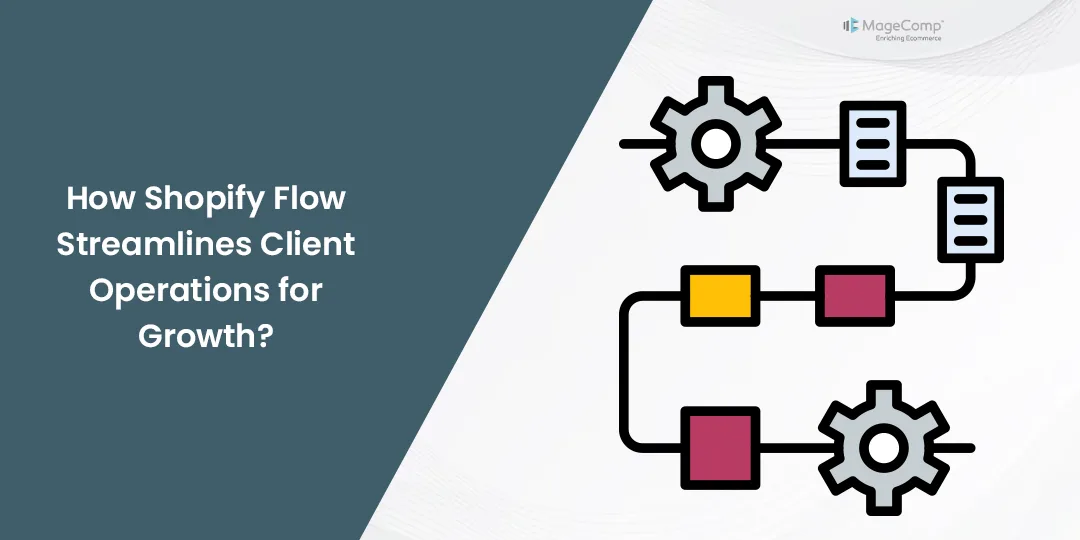In the dynamic realm of e-commerce, efficiency and adaptability are paramount for sustained growth. With the burgeoning demands of managing multiple tasks, orders, and customer interactions, businesses often find themselves juggling various operations simultaneously. In such a scenario, automation emerges as a game-changer, liberating entrepreneurs from repetitive tasks and allowing them to focus on strategic initiatives.
Shopify, a leading e-commerce platform, recognizes this need for seamless automation to drive business success. In this regard, Shopify Flow stands out as a powerful tool designed to streamline client operations and facilitate growth. Let’s delve into how Shopify Flow empowers businesses to optimize their processes and scale effectively.
What is Shopify Flow?
Shopify Flow is an automation platform integrated within the Shopify ecosystem, offering a user-friendly interface to create automated workflows. These workflows automate routine tasks and decision-making processes based on predefined triggers and actions, effectively reducing manual intervention and human error.
How Does Shopify Flow Work?
Here’s how Shopify Flow works:
Trigger Events
The process starts with defining trigger events, which are specific actions or conditions that initiate a workflow. These triggers can be based on various events within the Shopify platform, such as when an order is placed, when a product goes out of stock, when a customer abandons a cart, or when a specific tag is applied to a customer or order.
Conditions
After setting up trigger events, users can define conditions that must be met for the workflow to proceed. These conditions can include factors like order value, customer location, product attributes, or specific tags associated with customers or products.
Actions
Once the trigger events and conditions are established, users can specify the actions they want Shopify Flow to take when those conditions are met. Actions can include tasks such as sending emails to customers, updating order statuses, applying discounts, tagging products or customers, creating tasks in project management tools, or integrating with third-party applications.
Workflow Creation
Using a user-friendly interface, users can visually design their workflows by connecting trigger events, conditions, and actions using a drag-and-drop editor. This allows for the creation of highly customized and intricate automation sequences tailored to the specific needs of the business.
Execution
Once a workflow is created and activated, Shopify Flow continuously monitors the defined trigger events and conditions. When a trigger event occurs and the associated conditions are met, Shopify Flow automatically executes the specified actions, eliminating the need for manual intervention.
Monitoring and Optimization
Users can monitor the performance of their workflows through analytics and reporting tools provided by Shopify Flow. This allows them to track the effectiveness of their automation efforts, identify areas for improvement, and make adjustments as needed to optimize their workflows over time.
Benefits of Shopify Flow
Simplifying Complex Operations
One of the most significant advantages of Shopify Flow is its ability to simplify complex operations. With a drag-and-drop interface, users can easily create workflows tailored to their specific business needs. Whether it’s managing inventory, processing orders, or segmenting customers, Shopify Flow empowers businesses to automate repetitive tasks seamlessly.
For instance, businesses can set up workflows to trigger email notifications for low-stock items, automatically apply discounts based on customer behavior, or route orders to fulfillment centers based on location—all without manual intervention. This not only saves time but also ensures consistency and accuracy across operations.
Enhancing Customer Experience
In today’s competitive landscape, delivering exceptional customer experiences is non-negotiable. Shopify Flow enables businesses to enhance customer interactions through personalized automation. By leveraging customer data and behavioral triggers, businesses can create targeted workflows to engage customers at every stage of their journey.
For example, businesses can automate personalized email campaigns based on customer preferences, reward loyal customers with exclusive discounts, or offer proactive support by triggering follow-up emails after purchase. These automated interactions not only foster customer loyalty but also free up valuable resources for strategic initiatives.
Driving Scalable Growth
As businesses expand and diversify, scalability becomes a critical consideration. Shopify Flow serves as a catalyst for scalable growth by automating processes that would otherwise require additional manpower and resources. By streamlining operations and reducing manual overhead, businesses can efficiently manage increased sales volumes and market complexities.
Furthermore, Shopify Flow adapts to evolving business needs, allowing users to modify workflows on the fly. Whether it’s adding new triggers, adjusting decision criteria, or integrating with third-party apps, businesses can scale their automation initiatives seamlessly as they grow.
Data-Driven Insights
Shopify Flow provides analytics and reporting tools that allow businesses to track the performance of their workflows and measure the impact of automation on their operations. By analyzing key metrics and trends, businesses can gain valuable insights into their processes, identify areas for improvement, and make data-driven decisions to optimize their workflows over time.
Integration Capabilities
Shopify Flow seamlessly integrates with other Shopify apps and third-party tools, allowing businesses to extend and enhance their automation capabilities. Whether it’s integrating with inventory management systems, customer relationship management (CRM) platforms, or accounting software, Shopify Flow enables businesses to create a unified ecosystem that streamlines their operations and drives growth.
How Shopify Flow Can Help Your Clients Grow?
In the ever-evolving world of e-commerce, staying ahead of the curve is essential for businesses looking to thrive and grow. One of the most powerful tools available to assist in this endeavor is Shopify Flow. Designed to automate tasks and streamline operations, Shopify Flow can be a game-changer for businesses seeking to scale their operations and drive growth. Here are five ways Shopify Flow can help your clients achieve their growth objectives:
Streamlining Order Processing
Order processing is a critical aspect of any e-commerce business, but it can also be time-consuming and prone to errors when done manually. Shopify Flow automates this process by setting up workflows that trigger actions based on specific conditions. For example, businesses can create workflows to automatically tag and prioritize high-value orders, route orders to the nearest fulfillment center for faster delivery, or send personalized order confirmation emails to customers—all without manual intervention. By streamlining order processing, businesses can improve efficiency, reduce errors, and provide a better customer experience, ultimately driving growth.
Personalizing Customer Interactions
In today’s competitive e-commerce landscape, personalized customer interactions can make all the difference in driving sales and fostering loyalty. Shopify Flow enables businesses to create personalized workflows based on customer behavior, preferences, and purchase history. For instance, businesses can set up workflows to send targeted email campaigns to customers who have abandoned their shopping carts, offer personalized product recommendations based on past purchases, or provide exclusive discounts to loyal customers. By personalizing customer interactions, businesses can increase engagement, build stronger relationships, and ultimately, drive repeat sales and referrals.
Automating Marketing Campaigns
Marketing campaigns play a crucial role in attracting new customers and driving revenue, but managing them manually can be time-consuming and resource-intensive. Shopify Flow allows businesses to automate various aspects of their marketing campaigns, from email marketing to social media advertising. For example, businesses can create workflows to automatically send follow-up emails to customers who have made a purchase, schedule social media posts to promote upcoming sales or events, or segment customers based on their buying behavior for targeted marketing campaigns. By automating marketing campaigns, businesses can save time and resources while reaching a larger audience and driving more sales.
Optimizing Inventory Management
Effective inventory management is essential for ensuring that businesses have the right products available at the right time to meet customer demand. Shopify Flow helps businesses optimize their inventory management processes by automating tasks such as inventory replenishment, stock level monitoring, and supplier communications. For example, businesses can create workflows to automatically reorder products when inventory levels fall below a certain threshold, update product listings to reflect changes in stock availability, or notify suppliers when new stock is needed. By optimizing inventory management, businesses can minimize stockouts, reduce carrying costs, and improve overall operational efficiency, ultimately driving growth.
Scaling Operations Seamlessly
As businesses grow and expand, managing increasingly complex operations can become a significant challenge. Shopify Flow helps businesses scale their operations seamlessly by automating processes and workflows that would otherwise require manual intervention. For example, businesses can create workflows to automate repetitive tasks such as order processing, customer support ticket routing, or inventory management, freeing up time and resources to focus on strategic initiatives. Additionally, Shopify Flow integrates seamlessly with other Shopify apps and third-party tools, allowing businesses to customize and extend their automation capabilities as needed. By scaling operations seamlessly, businesses can accommodate growth without sacrificing efficiency or customer experience, ultimately driving sustainable long-term growth.
Conclusion
In a rapidly evolving e-commerce landscape, agility and efficiency are indispensable for sustained success. Shopify Flow emerges as a versatile tool that empowers businesses to streamline operations, enhance customer experiences, and drive scalable growth. By automating routine tasks and decision-making processes, businesses can focus on innovation, strategic initiatives, and ultimately, achieving their growth objectives. As the e-commerce landscape continues to evolve, Shopify Flow remains a valuable ally for businesses seeking to thrive in an increasingly competitive marketplace.
Now that you have got clear idea about Shopify Flow and how it is useful for your business growth, check out How to Create a Workflow with Shopify Flow.












